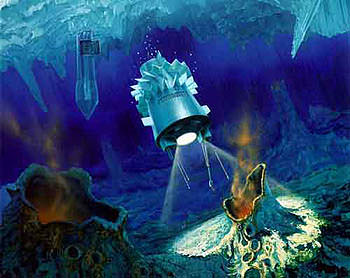Europa’s water exists in a layer around the planet, encased in a layer of ice. Could there be life down there?
Hooray! Welcome to the 200th official episode of the Guide To Space!
First off, thank you. Thank you for watching, liking, sharing, subscribing and being a patron of our show. Yes, you. Thank you.
So to celebrate, a few weeks ago we invited the members of the Weekly Space Hangout Crew Google+ Community to suggest topics for episodes, and the winner would receive a precious iron-nickel meteorite. Congratulations Andres Munoz, this meteorite is for you.
This episode, chosen by Andres, is for everyone.
The search for life in the Solar System is about the hunt for water. Wherever we find liquid water on Earth, we find life. I’m talking everywhere. In the most briny, salty pools in Antarctica, in the hottest hot springs in Yellowstone, under glaciers, and kilometers deep underground.
So we go searching for liquid water in the Solar System.
You might be surprised to learn that Jupiter’s moon Europa has the most water in the entire Solar System. If you took all the water on Earth, collected it into a big sphere, it would measure almost 1,400 kilometers across.
Europa’s water would measure nearly 1,800 kilometers.All that water exists in a layer around Europa, encased in a layer of ice. How thick? We don’t know.
Is there life down there? We don’t know.You can say there might be, and it wouldn’t be untrue. However, if you say there isn’t, that’s way less interesting for clickbait purposes. Whenever we don’t know the answers to fundamental and intriguing questions like that, it’s time to send a mission.
Good news! An actual mission to Europa is in the works right now. In 2015, NASA approved the development of an orbiter mission to Europa. If all goes well, and nothing gets cancelled…
And nothing will get cancelled, right? Right? I heard Firefly. Which one of you said Firefly?!?
According to the plan, a spacecraft will launch in the 2020s, carrying 9 instruments to Europa. Most will be familiar cameras, mass spectrometers, and the like, to study the surface of Europa to a high level of resolution. Over the course of 45 flybys, the spacecraft will get down as close as 25 kilometers and capture it with incredible resolution.

Perhaps the most exciting, and controversial instrument on board the new Europa Orbiter mission will be its ice-penetrating radar. Mission planners battled over installing a radar this sophisticated, as it will be an enormous drain on the orbiter’s power.
This for us is incredibly exciting. It will allow the spacecraft to map out the depth and thickness of Europa’s icy exterior. Is it thick or thin? Are there pockets of water trapped just below the surface, or is it tough shell that goes on for dozens of kilometers?
The worst case scenario is that the shell goes thicker than the radar can reach, and we won’t even know how far it goes.
Whatever happens, the Europa orbiter will be a boon to science, answer outstanding questions about the moon and the chances of finding life there.
We’re just getting started. What we really want to send is a lander. Because of the intense radiation from Jupiter, the Sun, and space itself, the surface of the ice on Europa would be sterilized. But dig down a few centimeters and you might find life that’s protected from the radiation.
A future Europa lander might be equipped with a heated drill attached to a tether. The lander would be have with a heat-generated radioisotope thermoelectric generator, like most of NASA’s big, outer Solar System spacecraft.

But in addition to using it for electricity, it’ll use the raw heat to help a tethered drill to grind through the ice a few meters and sample what’s down there.
Drilling more than a few meters is probably the stuff of science fiction. Russian scientists in Antarctica drilled for almost two decades to get through 4,000 meters of ice above Lake Vostok. Imagine trying to get through 100 kilometers of the stuff, on a distant world, with a robot.
But, since I’ve talked about moving the Sun, and terraforming the Moon, maybe I shouldn’t put any bounds on my imagination. Nuclear-powered Europa submarines will get us swimming with the singing Europan space whales in no time.
Europa is the best place to search the Solar System for life, and I’m excited to see what the upcoming Europa Orbiter mission turns up. And I’m even more excited about the possibility of any future lander missions.
It was a lot of fun wrapping my brain around a topic chosen by the fans. What topic would you like us to cover next? I’ve got a whole pocket of meteorites here. Put it in the comments below.
First, I want to thank everyone. It’s been a crazy race getting up to 200 episodes, but it’s been a blast all the way through. Thanks again for all your support and here’s to 200 more!


I said Firefly – and New Horizon’s previous incarnations. LOL But yet’s go – there’s even a movie about it like we’ve been there already (at some indeterminate near future) – https://en.wikipedia.org/wiki/Europa_Report
Europa is the Big one if we do not find life on Mars (sub surface) then Europa looks promising we know liquid water is under the ice and where water is liquid we find life its a perfect combo…
If we do find alien life, what are we supposed to do with it? Kill it and eat it as usual? Or try to talk to it? The ancient Egyptians didn’t scribe much but the bookkeeping of who owns what. Really boring reading. Killing and eating seems to be the only fun thing to do with them. A comforting snack under the dark night sky.
Yummy. Can’t wait to “meat” you, I’m licking my tongue across the edges of my sharp teeth, waiting for you out there to come to me, or I will come to you. Aliens aren’t dangerous, we are. We killed all other apes already while we were growing up. Imagine what we can kill now! We ARE the masters of the universe.
I vote YES! Let’s send a probe to Europa!
Thank you so much for all your hard work. Thank goodness there weren’t any distractions along the way to block you from reaching this milestone! LOL~?
Umm er, could this be a good subject for an episode? “Why and how we did it and the hurdles we’ve had to leap! Who we’ve met and how far you had to travel…”
Will they be able to tell whether it is “heavy” water or not?
This patreon thing is a failure. More clicks and for what?
Suggestion for name of mission to Europa:
SearCH for Life on Europa Probe = SCHLEP
I say, skip straight to the ice penetrator mission, or piggyback it with an orbiter – even better
As for not being able to drill more than a few meters: Don’t drill, melt your way down, all the way through, using gravity, more heat, and a longer tether. You could leave it dangling down there for years, like ice fishing, sending back data via the tether.
A true submarine rover would be even better, but I think the penetrator could be done on the cheap.
I don’t want to know what’s two meters deep in the ice; I want to know what’s swimming (or building cities) beneath!
Fraser, please for the love of god check your facts before posting.
It did not take the Russians two decades to drill 4000 meters. First off, it wasn’t just the Russians, it was a joint effort, Russia, U.S. and France. Second, they stopped, intentionally, before reaching water because they were using Freon and kerosene to keep there bore hole refreezing. I don’t think it takes a rocket scientist to see the problem here, drilling into a body of water that has not been touched in 20 million years only to instantly pollute it with toxic chemicals? Not smart.The thing that took two decades to do is to find a way to sample the water without contaminating it. If they simply wanted to drill to the lake, consequences be damned, they would have done it within the first year.
I’ve said this before to other people, now I’m saying it again, to you.
If Wikipedia has better information than you, you have a serious problem.
you don`t need to drill…if you just watch a second the photo yu`ll see dirt ice along the cracks. Just send a robot to colect some dirty ice, melt the sample, watch it at a microscope, analise it and that`s all.